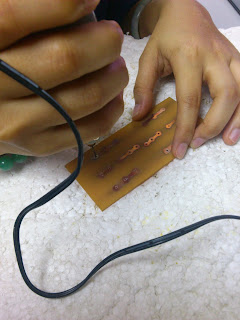OBJECTIVE:
- to prepare for engineer day presentation.
ACTIVITY:
- Analysed the last output for all type.
- Making poster for engineer days
The result from Figure 4.2, 4.3,4,4 has been combine at
Figure 4.3. Form this result can be analysed the best output will generate
between the type. Blue line is result for type 1, red line is result for type 2
and green line for type 3. The maximum
power in type 1 is 4.6W. The maximum power in type 2 is 4.37V and 5.6W in type
3. There is no much difference between type 1 and type 2 because the difference
temperature cold side and hot side is not much between type 1 and 2. Thermoelectric principle is when the difference temperature is increase, the
higher output will generate. Type
3 has most large max power between other type because of the large difference
temperature between inside and outside building temperature.
In this week need to do demonstration and presentation about development and performance analysis PV-TE energy harvester prototype on building wall by using labVIEW.
ENGINEER'S DAY


































